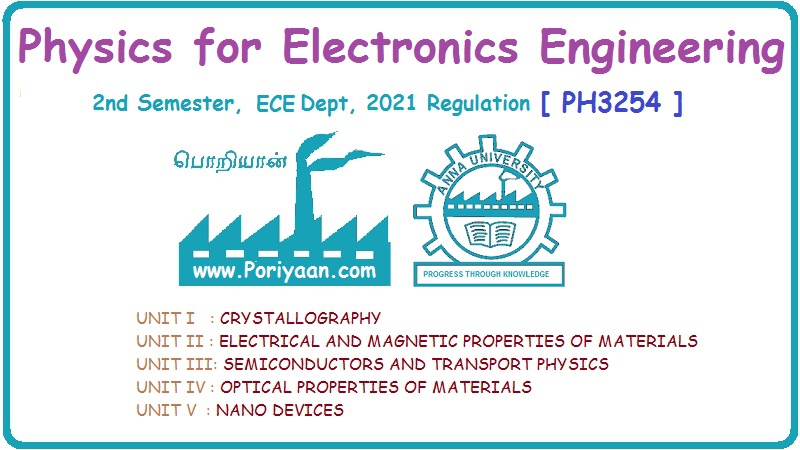Physics for Electronics Engineering: Unit V: Nano Devices
Introduction of Nano Devices
A nanometre (nm) is one billionth (1/109) of a metre. For comparison, thickness of a single human hair is about 80,000 nm (80 µm), a red blood cell is approximately 7,000 nm (7 µm) wide and a water molecule is almost 0.3 nm across.
NANO DEVICES
INTRODUCTION
A
nanometre (nm) is one billionth (1/109) of a metre. For comparison,
thickness of a single human hair is about 80,000 nm (80 µm), a red blood cell
is approximately 7,000 nm (7 µm) wide and a water molecule is almost 0.3 nm
across.
Scientists
and engineers are nowadays interested in nanoscale which is from 1 nm to 100
nm. At nanoscale, the properties of materials are very different from those at
larger scale. Therefore, the nano-world is in between quantum world and macro
world.
Nanoscience
It
is concerned with the study of phenomena and manipulation of materials at
nanometre scale.
Nanotechnology
It is the design, characterization, production and application roof structures, devices and systems by controlling shape and size at the nanometre scale.
Nanotechnology
means making use of the unique physical properties of atoms, molecules and
other materials measuring roughly 1 to 100 nanometre.
The
word "nano" comes from nanos, a Greek word meaning dwarf.
Presently,
we are using many devices made of nanoelectronic devices. The microelectronics
industry was born out of the invention of the bi-polar transistor in 1947 and
by the invention of the integrated circuit (IC) in 1958.
Gordon Moore (co-founder of INTEL
Corporation) observed that the number of transistors
per square inch on IC chip roughly doubled by every 18 to 24 months. This
general rule of thumb is now called as "Moore's law".
By
1960, the minimum feature size of a transistor was approximately 100 µm. At
present, manufacturing technology is at transistor size of 22 nm.
Because
of the diminishing feature size of transistors and other components, we can say
that the electronics industry is already "doing" nanotechnology.
Nanomaterials
Definition
Nanophase
materials are newly developed materials with grain size at the nanometre range
(10-9 m), i.e., in the order of 1 - 100 nm. The particle size in a
nano material is 1- 100 nm. They are are simply called nanomaterials.
Different forms of Nanomaterials
Nano-structured material
The structures whose characteristic variations in design length is at the nanoscale.
Nano particles
The
particles size in the order of 10-9 m are called nanoparticles.
Nano dots
Nanoparticles
which consist of homogeneous material, especially those that are almost
spherical or cubical in shape.
Nanorods
Nanostructures
which are shaped like long sticks or rods with diameter in nanoscale and a
length very much longer.
Nanotubes
Nanotubes
are nanoscale materials that has a tube like (hollow cylinder) structure.
Nanowires
Nanowires
are solid rod-like material with diameter of few nanometres or less.
Fullerenes
A
form of carbon having a large molecule consisting of an empty cage of 60 or
more carbon atoms.
Nanocomposites
Composite
structures whose characteristic dimensions are found at nanoscale.
Cluster
A
collection of units (atoms or reactive molecules) upto few tens of units.
Colloids
A
stable liquid phase containing particles in the 1-1000 nm range.
Nano electronics
Nanoelectronics refers to the use of nanotechnology in electronic components, especially transistors.
It
often refers to transistor devices that are so small that inter-atomic
interactions and quantum mechanical properties need to be studied extensively.
Besides,
being small and allowing more transistors to be packed into a single chip, the
uniform and symmetrical structure of nanotubes allows a higher electron
mobility, a symmetrical electron/hole characteristic.
Need for Nanotechnology in
Electronics
Today
microelectronics are used to solve most of the problems.
The
two exceptional disadvantages of micro electronics are:
i.
Physical size
ii.
Increasing cost of fabrication of integrated circuits.
To
overcome these disadvantages, nanotechnology is used.
Advantages of Using Nanotechnology
in Electronics
i.
Increasing the density of memory chips.
ii.
Decreasing the weight and thickness of the screens.
iii.
Nanolithography is used for fabrication of chips.
iv.
Reducing the size of transistors used in integrated circuits.
v.
Improving display screens on electronic devices.
vi.
Reducing power consumption.
Physics for Electronics Engineering: Unit V: Nano Devices : Tag: : - Introduction of Nano Devices
Related Topics
Related Subjects
Physics for Electronics Engineering
PH3254 - Physics II - 2nd Semester - ECE Department - 2021 Regulation | 2nd Semester ECE Dept 2021 Regulation
